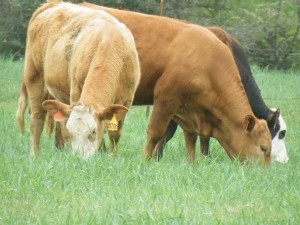Stocking Rate vs. Grazing Pressure: Understanding the Balance for Effective Grazing Management
Grazing management is a cornerstone of sustainable forage production. Two key concepts—stocking rate and grazing pressure—are often used interchangeably, but they represent different aspects of pasture utilization. Understanding the distinction and how they influence forage systems is essential for maintaining pasture health, animal performance, and long-term productivity.
What Is Stocking Rate?
Stocking rate refers to the number of animals grazing a unit of land over a specific period. It’s typically expressed as:
- Animal units per acre
- Acres per animal unit
An animal unit (AU) is commonly defined as one mature cow weighing approximately 1,000 pounds, consuming about 26 pounds of dry matter per day.
Example:
If you have 10 cows grazing 20 acres, your stocking rate is 0.5 AU/acre.
What Is Grazing Pressure?
Grazing pressure considers the relationship between forage availability and animal demand. It’s a dynamic measure that reflects:
- Forage growth rate
- Animal intake
- Grazing duration
While stocking rate is a static number, grazing pressure helps determine whether forage supply meets livestock needs over time.
Why It Matters
Balancing stocking rate and grazing pressure is critical for:
- Preventing overgrazing, which damages root systems and reduces regrowth.
- Avoiding underutilization, which leads to forage waste and weed encroachment.
- Maintaining forage quality.
- Supporting root development, especially in perennial forages that rely on energy reserves stored in roots.
Grazing Management Tips
- Monitor Forage Availability
- Use pasture condition scores or visual estimates.
- Adjust stocking rate seasonally based on growth patterns.
- Rotate Grazing
- Allow rest periods for forage recovery.
- Match rotation timing to forage species and growth stage.
- Use Temporary Fencing
- Create flexible paddocks to manage grazing pressure.
- Improve utilization and reduce selective grazing.
- Test Soil and Fertility
- Fertile soils support faster regrowth and higher carrying capacity.
- Apply nutrients based on forage needs and soil test results.
- Record and Adjust
- Track animal performance, pasture condition, and forage yield.
- Adjust stocking rate and grazing duration as needed.
Conclusion
Effective grazing management requires more than just counting animals per acre. By understanding both stocking rate and grazing pressure, producers can make informed decisions that protect forage resources, support livestock productivity, and promote long-term pasture health.
Vanessa Corriher-Olson, Ph.D
Professor, Forage Extension Specialist
Soil & Crop Sciences
Overton, TX
Texas A&M AgriLife Extension Service
Texas A&M University System

